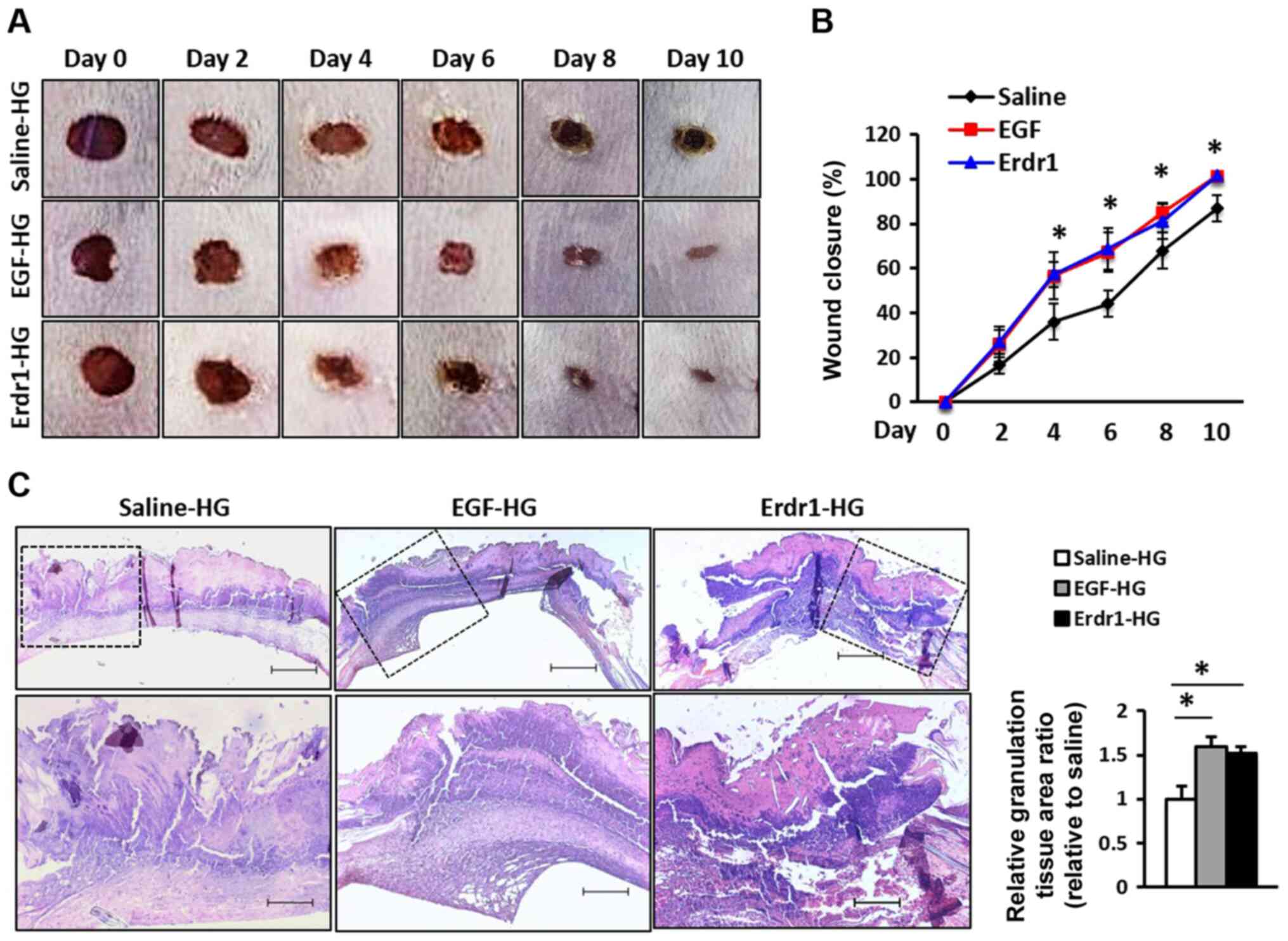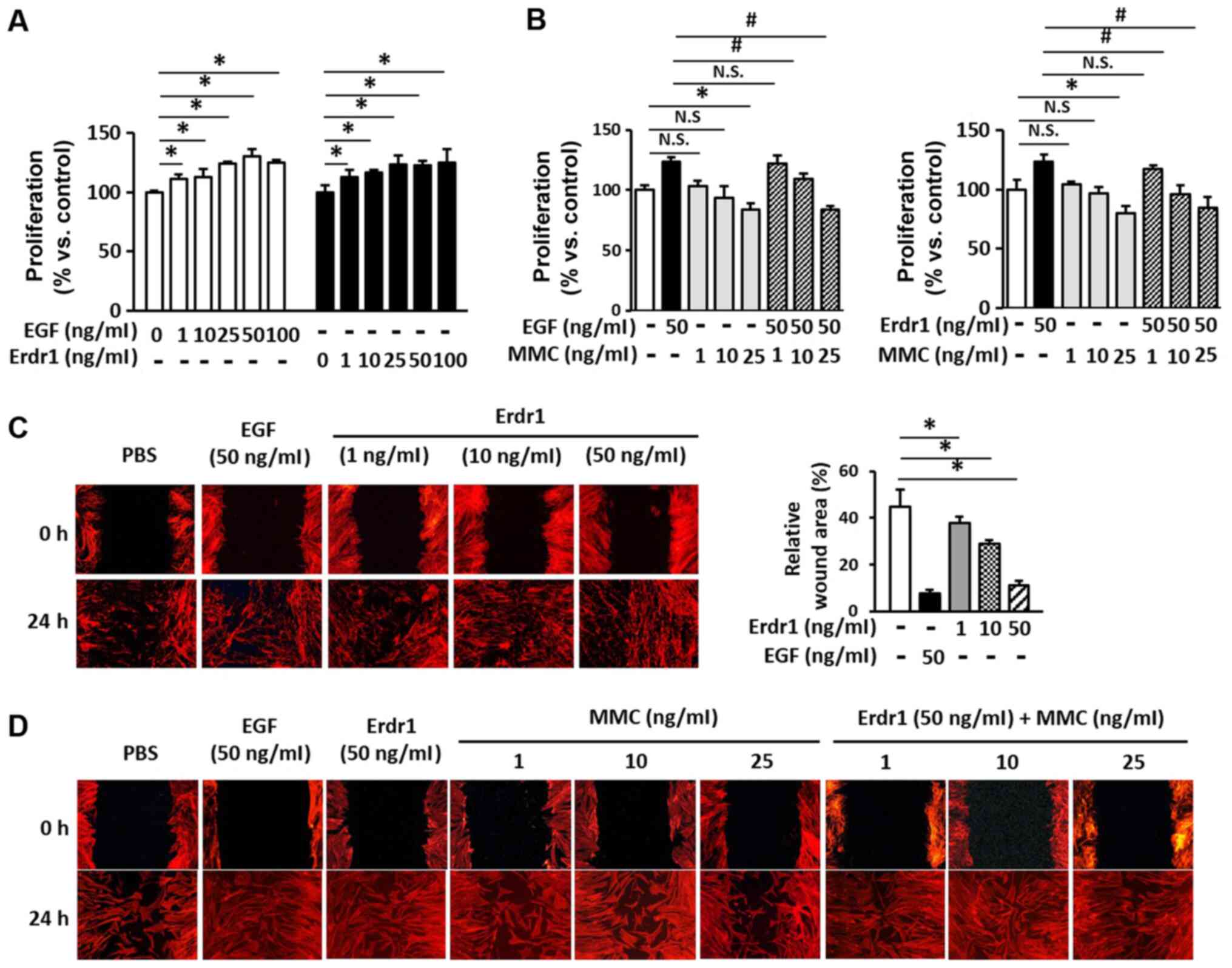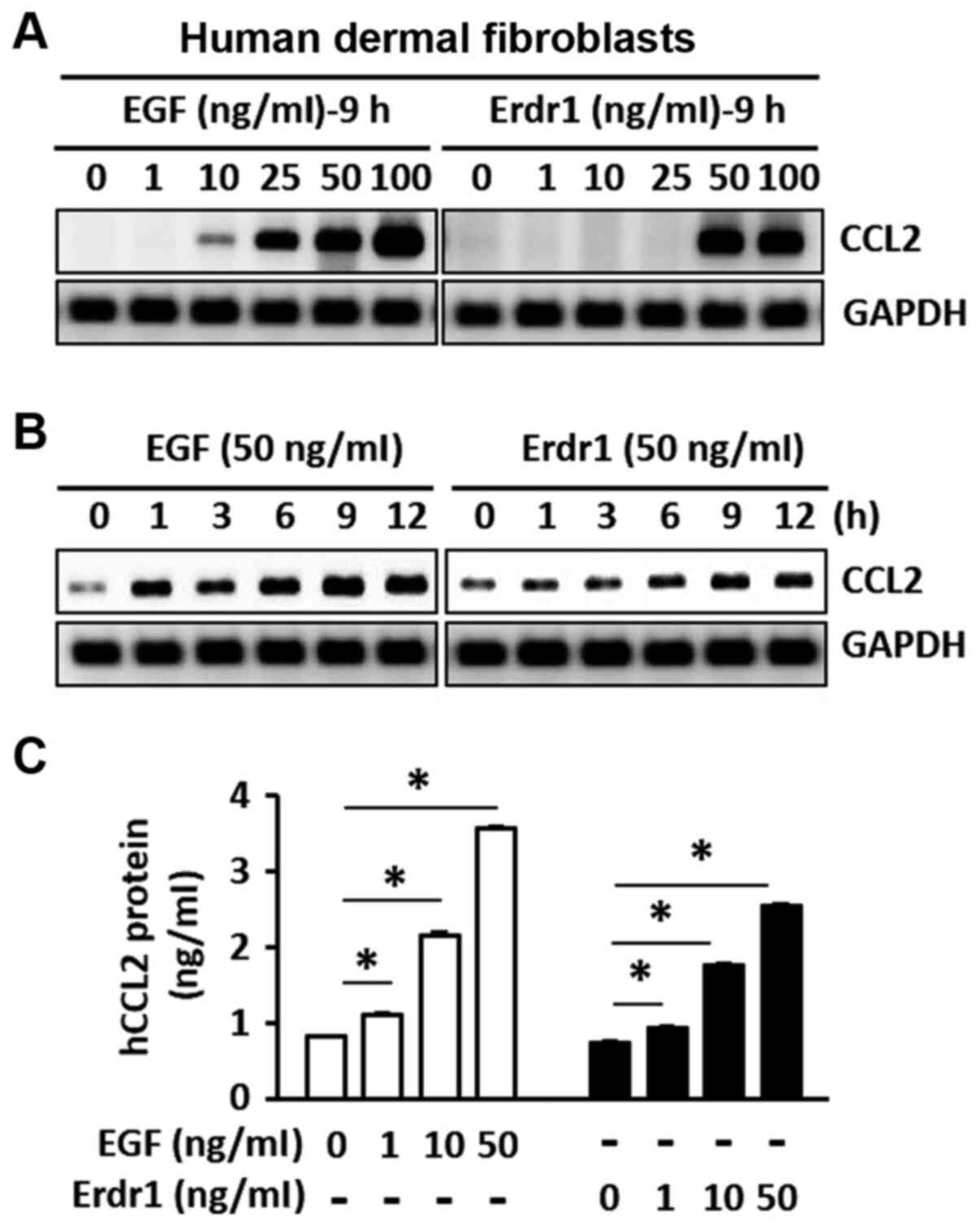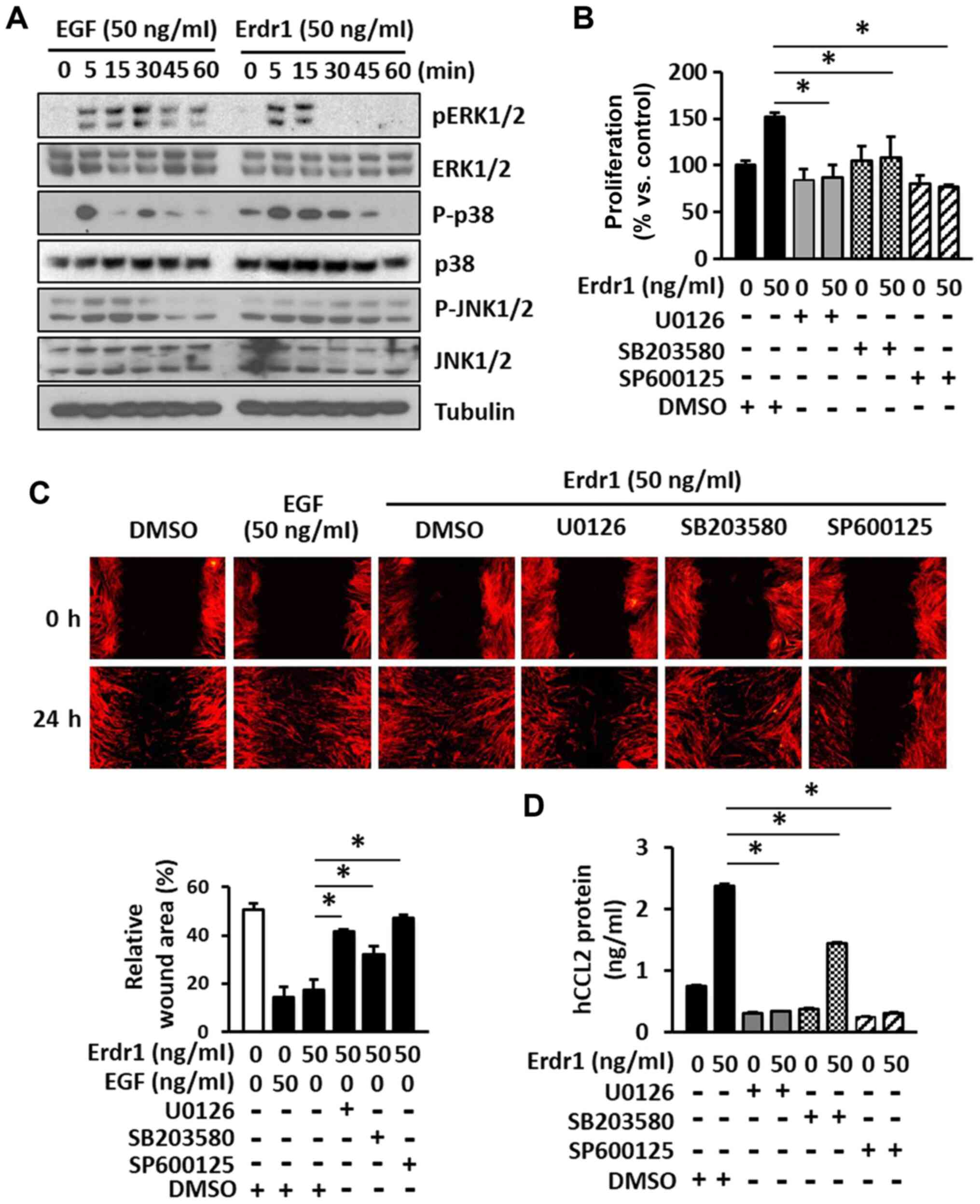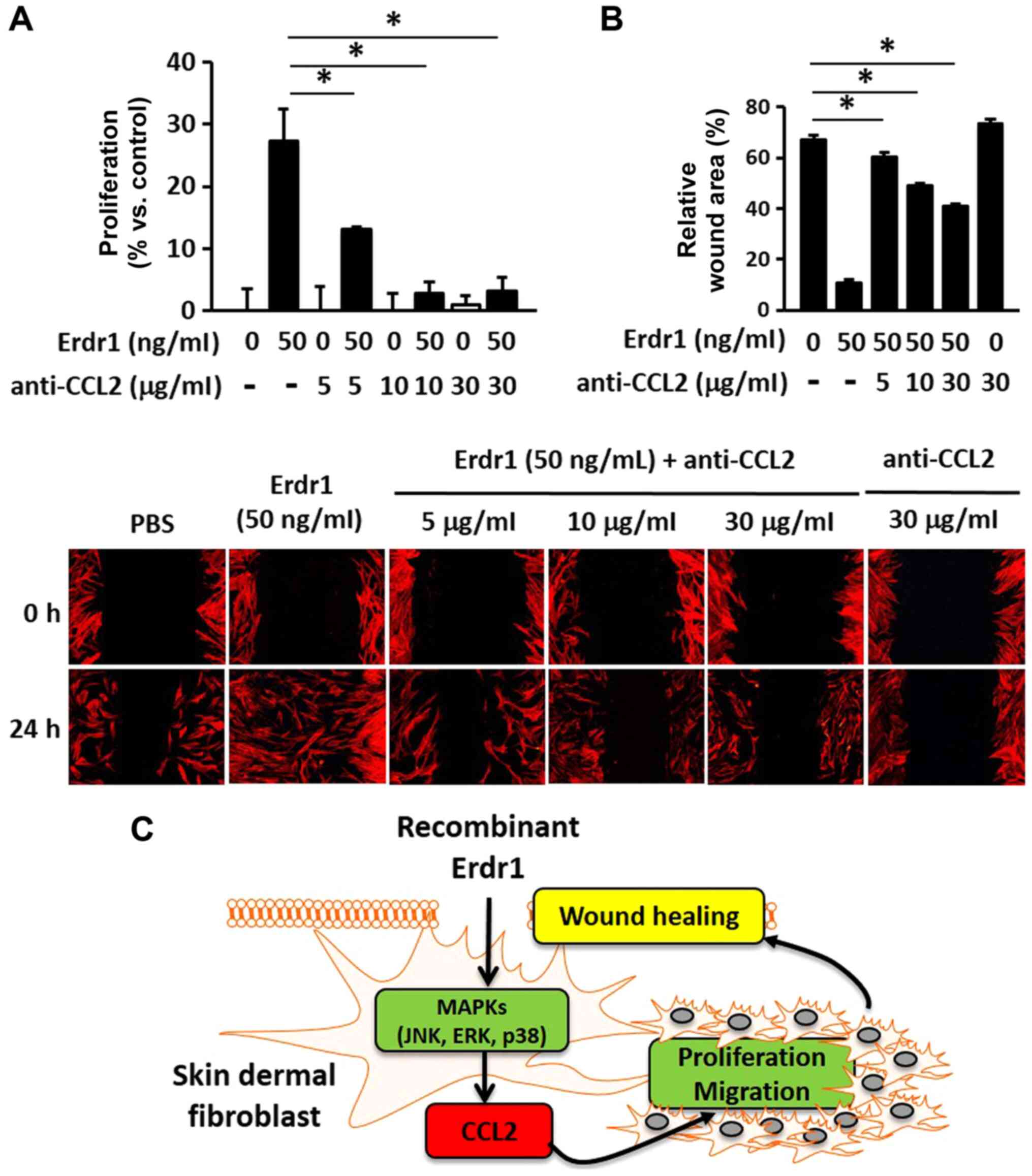|
1
|
Singer AJ and Clark RA: Cutaneous wound
healing. N Engl J Med. 341:738–746. 1999. View Article : Google Scholar : PubMed/NCBI
|
|
2
|
Darby IA, Laverdet B, Bonte F and
Desmouliere A: Fibroblasts and myofibroblasts in wound healing.
Clin Cosmet Investig Dermatol. 7:301–311. 2014.PubMed/NCBI
|
|
3
|
Walraven M, Gouverneur M, Middelkoop E,
Beelen RH and Ulrich MM: Altered TGF-ß signaling in fetal
fibroblasts: What is known about the underlying mechanisms? Wound
Repair Regen. 22:3–13. 2014. View Article : Google Scholar
|
|
4
|
Lee BC, Song J, Lee A, Cho D and Kim TS:
Visfatin promotes wound healing through the activation of ERK1/2
and JNK1/2 pathway. Int J Mol Sci. 19:36422018. View Article : Google Scholar :
|
|
5
|
Kanazawa S, Fujiwara T, Matsuzaki S,
Shingaki K, Taniguchi M, Miyata S, Tohyama M, Sakai Y, Yano K,
Hosokawa K and Kubo T: bFGF regulates PI3-kinase-Rac1-JNK pathway
and promotes fibroblast migration in wound healing. PLoS One.
5:e122282010. View Article : Google Scholar : PubMed/NCBI
|
|
6
|
Barrientos S, Stojadinovic O, Golinko MS,
Brem H and Tomic-Canic M: Growth factors and cytokines in wound
healing. Wound Repair Regen. 16:585–601. 2008. View Article : Google Scholar
|
|
7
|
Lichtman MK, Otero-Vinas M and Falanga V:
Transforming growth factor beta (TGF-ß) isoforms in wound healing
and fibrosis. Wound Repair Regen. 24:215–222. 2016. View Article : Google Scholar
|
|
8
|
Raja, Sivamani K, Garcia MS and Isseroff
RR: Wound re-epithelialization: Modulating keratinocyte migration
in wound healing. Front Biosci. 12:2849–2868. 2007. View Article : Google Scholar : PubMed/NCBI
|
|
9
|
Ding J and Tredget EE: The role of
chemokines in fibrotic wound healing. Adv Wound Care (New
Rochelle). 4:673–686. 2015. View Article : Google Scholar
|
|
10
|
Rees PA, Greaves NS, Baguneid M and Bayat
A: Chemokines in wound healing and as potential therapeutic targets
for reducing cutaneous scarring. Adv Wound Care (New Rochelle).
4:687–703. 2015. View Article : Google Scholar
|
|
11
|
DiPietro LA, Polverini PJ, Rahbe SM and
Kovacs EJ: Modulation of JE/MCP-1 expression in dermal wound
repair. Am J Pathol. 146:868–875. 1995.PubMed/NCBI
|
|
12
|
Wetzler C, Kampfer H, Stallmeyer B,
Pfeilschifter J and Frank S: Large and sustained induction of
chemokines during impaired wound healing in the genetically
diabetic mouse: Prolonged persistence of neutrophils and
macrophages during the late phase of repair. J Invest Dermatol.
115:245–253. 2000. View Article : Google Scholar : PubMed/NCBI
|
|
13
|
Low QE, Drugea I A, Duffner LA, Quinn DG,
Cook DN, Rollins BJ, Kovacs EJ and DiPietro LA: Wound healing in
MIP-1alpha(-/-) and MCP-1(-/-) mice. Am J Pathol. 159:457–463.
2001. View Article : Google Scholar : PubMed/NCBI
|
|
14
|
Engelhardt E, Toksoy A, Goebeler M, Debus
S, Brocker EB and Gillitzer R: Chemokines IL-8, GROalpha, mcp-1,
IP-10, and Mig are sequentially and differentially expressed during
phase-specific infiltration of leukocyte subsets in human wound
healing. Am J Pathol. 153:1849–1860. 1998. View Article : Google Scholar : PubMed/NCBI
|
|
15
|
Dipietro LA, Reintjes MG, Low QE, Levi B
and Gamelli RL: Modulation of macrophage recruitment into wounds by
monocyte chemoattractant protein-1. Wound Repair Regen. 9:28–33.
2001. View Article : Google Scholar : PubMed/NCBI
|
|
16
|
Wood S, Jayaraman V, Huelsmann EJ, Bonish
B, Burgad D, Sivaramakrishnan G, Qin S, DiPietro LA, Zloza A, Zhang
C and Shafikhani SH: Pro-inflammatory chemokine CCL2 (MCP-1)
promotes healing in diabetic wounds by restoring the macrophage
response. PLoS One. 9:e915742014. View Article : Google Scholar : PubMed/NCBI
|
|
17
|
Lin Q, Fang D, Fang J, Ren X, Yang X, Wen
F and Su SB: Impaired wound healing with defective expression of
chemokines and recruitment of myeloid cells in TLR3-deficient mice.
J Immunol. 186:3710–3717. 2011. View Article : Google Scholar : PubMed/NCBI
|
|
18
|
Dormer P, Spitzer E, Frankenberger M and
Kremmer E: Erythroid differentiation regulator (EDR), a novel,
highly conserved factor I. Induction of haemoglobin synthesis in
erythroleukaemic cells. Cytokine. 26:231–242. 2004. View Article : Google Scholar : PubMed/NCBI
|
|
19
|
Jung MK, Houh YK, Ha S, Yang Y, Kim D, Kim
TS, Yoon SR, Bang SI, Cho BJ, Lee WJ, et al: Recombinant Erdr1
suppresses the migration and invasion ability of human gastric
cancer cells, SNU-216, through the JNK pathway. Immunol Lett.
150:145–151. 2013. View Article : Google Scholar : PubMed/NCBI
|
|
20
|
Lee YB, Kim HJ, Jung HY, Park YG, Kim SY,
Cho BK, Cho D and Park HJ: Downregulation of erythroid
differentiation regulator 1 as a novel marker of skin tumors. Int J
Dermatol. 53:723–730. 2014. View Article : Google Scholar
|
|
21
|
Jung MK, Park Y, Song SB, Cheon SY, Park
S, Houh Y, Ha S, Kim HJ, Park JM, Kim TS, et al: Erythroid
differentiation regulator 1, an interleukin 18-regulated gene, acts
as a metastasis suppressor in melanoma. J Invest Dermatol.
131:2096–2104. 2011. View Article : Google Scholar : PubMed/NCBI
|
|
22
|
Houh YK, Kim KE, Park HJ and Cho D: Roles
of erythroid differentiation regulator 1 (Erdrl) on inflammatory
skin diseases. Int J Mol Sci. 17:20592016. View Article : Google Scholar
|
|
23
|
Kim KE, Kim S, Park S, Houh Y, Yang Y,
Park SB, Kim S, Kim D, Hur DY, Kim S, et al: Therapeutic effect of
erythroid differentiation regulator 1 (Erdrl) on collagen-induced
arthritis in DBA/1J mouse. Oncotarget. 7:76354–76361. 2016.
View Article : Google Scholar : PubMed/NCBI
|
|
24
|
Kim KE, Houh Y, Lee J, Kim S, Cho D and
Park HJ: Downregulation of erythroid differentiation regulator 1
(Erdrl) plays a critical role in psoriasis pathogenesis. Exp
Dermatol. 25:570–572. 2016. View Article : Google Scholar : PubMed/NCBI
|
|
25
|
Kim KE, Houh Y, Park HJ and Cho D:
Therapeutic effects of erythroid differentiation regulator 1 on
imiquimod-induced psoriasis-like skin inflammation. Int J Mol Sci.
17:2442016. View Article : Google Scholar : PubMed/NCBI
|
|
26
|
Kim M, Kim KE, Jung HY, Jo H, Jeong SW,
Lee J, Kim CH, Kim H, Cho D and Park HJ: Recombinant erythroid
differentiation regulator 1 inhibits both inflammation and
angiogenesis in a mouse model of rosacea. Exp Dermatol. 24:680–685.
2015. View Article : Google Scholar : PubMed/NCBI
|
|
27
|
Asai J, Takenaka H, Hirakawa S, Sakabe JI,
Hagura A, Kishimoto S, Maruyama K, Kajiya K, Kinoshita S, Tokura Y
and Katoh N: Topical simvastatin accelerates wound healing in
diabetes by enhancing angiogenesis and lymphangiogenesis. Am J
Pathol. 181:2217–2224. 2012. View Article : Google Scholar : PubMed/NCBI
|
|
28
|
Matsubayashi Y, Ebisuya M, Honjoh S and
Nishida E: ERK activation propagates in epithelial cell sheets and
regulates their migration during wound healing. Curr Biol.
14:731–735. 2004. View Article : Google Scholar : PubMed/NCBI
|
|
29
|
Coutelle O, Hornig-Do HT, Witt A, Andree
M, Schiffmann LM, Piekarek M, Brinkmann K, Seeger JM, Liwschitz M,
Miwa S, et al: Embelin inhibits endothelial mitochondrial
respiration and impairs neoangiogenesis during tumor growth and
wound healing. EMBO Mol Med. 6:624–639. 2014. View Article : Google Scholar : PubMed/NCBI
|
|
30
|
Satish L, Babu M, Tran KT, Hebda PA and
Wells A: Keloid fibroblast responsiveness to epidermal growth
factor and activation of downstream intracellular signaling
pathways. Wound Repair Regen. 12:183–192. 2004. View Article : Google Scholar : PubMed/NCBI
|
|
31
|
Wahedi HM, Park YU, Moon EY and Kim SY:
Juglone ameliorates skin wound healing by promoting skin cell
migration through Rac1/Cdc42/PAK pathway. Wound Repair Regen.
24:786–794. 2016. View Article : Google Scholar : PubMed/NCBI
|
|
32
|
Chrissouli S, Pratsinis H, Velissariou V,
Anastasiou A and Kletsas D: Human amniotic fluid stimulates the
proliferation of human fetal and adult skin fibroblasts: The roles
of bFGF and PDGF and of the ERK and Akt signaling pathways. Wound
Repair Regen. 18:643–654. 2010. View Article : Google Scholar : PubMed/NCBI
|
|
33
|
Jiang WG, Ye L, Patel G and Harding KG:
Expression of WAVEs, the WASP (Wiskott-Aldrich syndrome protein)
family of verprolin homologous proteins in human wound tissues and
the biological influence on human keratinocytes. Wound Repair
Regen. 18:594–604. 2010. View Article : Google Scholar : PubMed/NCBI
|
|
34
|
Aya KL and Stern R: Hyaluronan in wound
healing: Rediscovering a major player. Wound Repair Regen.
22:579–593. 2014. View Article : Google Scholar : PubMed/NCBI
|
|
35
|
Eming SA, Martin P and Tomic-Canic M:
Wound repair and regeneration: Mechanisms, signaling, and
translation. Sci Transl Med. 6:265sr2662014. View Article : Google Scholar
|
|
36
|
Rosinczuk J, Taradaj J, Dymarek R and
Sopel M: Mechanoregulation of wound healing and skin homeostasis.
Biomed Res Int. 2016:39434812016. View Article : Google Scholar : PubMed/NCBI
|
|
37
|
Rosique RG, Rosique MJ and Farina Junior
JA: Curbing inflammation in skin wound healing: A review. Int J
Inflam. 2015:3162352015. View Article : Google Scholar : PubMed/NCBI
|
|
38
|
Soto R, Petersen C, Novis CL, Kubinak JL,
Bell R, Stephens WZ, Lane TE, Fujinami RS, Bosque A, O'Connell RM
and Round JL: Microbiota promotes systemic T-cell survival through
suppression of an apoptotic factor. Proc Natl Acad Sci USA.
114:5497–5502. 2017. View Article : Google Scholar : PubMed/NCBI
|
|
39
|
Woo YR, Hwang S, Jeong SW, Cho DH and Park
HJ: Erythroid differentiation regulator 1 as a novel biomarker for
hair loss disorders. Int J Mol Sci. 18:3162017. View Article : Google Scholar :
|
|
40
|
Zhang M and Zhao X: Alginate hydrogel
dressings for advanced wound management. Int J Biol Macromol.
162:1414–1428. 2020. View Article : Google Scholar : PubMed/NCBI
|
|
41
|
Francesko A, Petkova P and Tzanov T:
Hydrogel dressings for advanced wound management. Curr Med Chem.
25:5782–5797. 2018. View Article : Google Scholar
|
|
42
|
Dhaliwal K and Lopez N: Hydrogel dressings
and their application in burn wound care. Br J Community Nurs.
23(Suppl 9): S24–S27. 2018. View Article : Google Scholar : PubMed/NCBI
|
|
43
|
Lu B, Rutledge BJ, Gu L, Fiorillo J,
Lukacs NW, Kunkel SL, North R, Gerard C and Rollins BJ:
Abnormalities in monocyte recruitment and cytokine expression in
monocyte chemoattractant protein 1-deficient mice. J Exp Med.
187:601–608. 1998. View Article : Google Scholar : PubMed/NCBI
|
|
44
|
Werner S and Grose R: Regulation of wound
healing by growth factors and cytokines. Physiol Rev. 83:835–870.
2003. View Article : Google Scholar : PubMed/NCBI
|
|
45
|
Craig MJ and Loberg RD: CCL2 (Monocyte
Chemoattractant Protein-1) in cancer bone metastases. Cancer
Metastasis Rev. 25:611–619. 2006. View Article : Google Scholar : PubMed/NCBI
|
|
46
|
Standiford TJ, Kunkel SL, Phan SH, Rollins
BJ and Strieter RM: Alveolar macrophage-derived cytokines induce
monocyte chemoattractant protein-1 expression from human pulmonary
type II-like epithelial cells. J Biol Chem. 266:9912–9918.
1991.PubMed/NCBI
|
|
47
|
Kusano KF, Nakamura K, Kusano H, Nishii N,
Banba K, Ikeda T, Hashimoto K, Yamamoto M, Fujio H, Miura A, et al:
Significance of the level of monocyte chemoattractant protein-1 in
human atherosclerosis. Circ J. 68:671–676. 2004. View Article : Google Scholar : PubMed/NCBI
|
|
48
|
Sartipy P and Loskutoff DJ: Monocyte
chemoattractant protein 1 in obesity and insulin resistance. Proc
Natl Acad Sci USA. 100:7265–7270. 2003. View Article : Google Scholar : PubMed/NCBI
|















